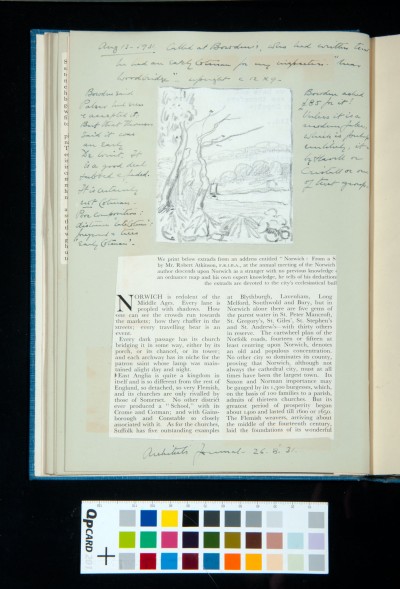Cotmania. Vol. VII. 1931-2
Archive: SDK Sydney Decimus Kitson Archive
Reference Number: SDK/1/2/1/7
Page: 6 verso
-
Description
Diary entry 13 August 1931
Newspaper cutting 26 August 1931(1) Kitson has been shown a watercolour (?) but considers it is not a Cotman.
(2) Description of Norwich as a city, with a mention of Crome and Cotman.Date: 1931
-
Transcription
Aug 13, 1931 Called at Bowden's, who had written that he had an early Cotman for my inspection. "Near Woodbridge", upright c 12 x 9.
Bowden said Palser had seen & accepted it. But that Thomson said it was an early De Wint. It is a good deal rubbed & faded. It is certainly not Cotman. Poor composition: distance 'late Cotman': foreground & trees 'early Cotman'.
[Sketch by Kitson]
Bowden asked £85 for it!
Unless it is a modern fake, which is perhaps unlikely, it is by Havell or Cristall or one of that group.[Newspaper cutting]
We print below extracts from an address entitled "Norwich: From a S[peech?]
by Mr. Robert Atkinson, F.R.I.B.A., at the annual meeting of the Norwich [...]
author descends upon Norwich as a stranger with no previous knowledge [...]
an ordnance map and his own expert knowledgge, he tells us of his deductions [...]
the extracts are devoted to the city's ecclesiastical buil[dings]
Norwich is redolent of the Middle Ages. Every lane is peopled with shadows. How one can see the crowds run towards the markets; how they chaffer in the streets; every travelling bear is an event.
Every dark passage has its church bridging it in some way, either by its porch, or its chancel, or its tower; and each archway has its niche for the patron saint whose lamp was maintained alight day and night.
East Anglia is quite a kingdom in itself and is so different from the rest of England, so detached, so very Flemish, and its churches are onlv rivalled by those of Somerset. No other district ever produced a "School," with its Crome and Cotman; and with Gainsborough and Constable so closely associated with it. As for the churches, Suffolk has five outstanding examples at Blythburgh, Lavenham, Long Melford, Southwold and Bury, but in Norwich alone there are five gems of the purest water in St. Peter Mancroft, St. Gregory's, St. Giles', St. Stephen's and St. Andrew's with thirty others in reserve. The cartwheel plan of the Norfolk roads, fourteen or fifteen at least centring upon Norwich, denotes an old and populous concentration. No other city so dominates its county, proving that Norwich, although not always the cathedral city, must at all times have been the largest town. Its Saxon and Norman importance may be gauged by its 1,300 burgesses, which, on the basis of 100 families to a parish, admits of thirteen churches. But its greatest period of prosperity began about 1400 and lasted till 1600 or 1650. The Flemish weavers, arriving about the middle of the fourteenth century, laid the foundations of its wonderful[Handwritten note by Kitson]
Architects' Journal, 26.8.'31.
